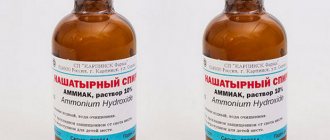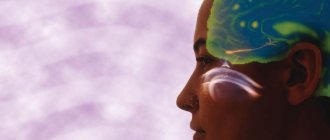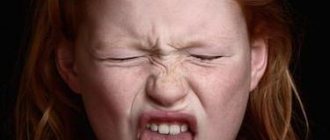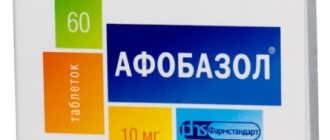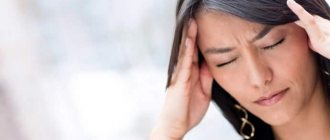For anxiety, fear, depression, as well as stress, memory loss and other problems with the central nervous system, medications are prescribed that have a positive effect on brain activity. Afobazol is considered one of the popular and effective drugs for adults. But is it allowed to give such medication to a child? What side effects and contraindications does the medicine have?
When fear and anxiety overcome, it is harmful to stay in this state for a long time, you need to seek help from a medical specialist.
Afobazol tablets belong to the therapeutic group of tranquilizers (anxiolytics). The drug is used to treat mental manifestations such as anxiety and tension. How to take Afobazol tablets correctly for an adult?
According to the instructions for use, Afobazol tablets have a milky or light cream color, a round, flat-cylindrical shape. Their main active component is considered to be morpholinoethylthioethoxybenzimidazole dihydrochloride; its concentration in one tablet can be five and ten milligrams. In addition, it contains additional substances, which include:
- Microcrystalline cellulose.
- Povidone.
- Magnesium stearate.
- Lactose.
- Potato starch.
The tablets are placed in blisters of twenty pieces (a total of 60 tablets in the package).
Pharmacological actions
The active component of Afobazole has an antiphobic effect and reduces anxiety. It does not affect benzodiazepine nerve endings, therefore it does not provoke a feeling of drowsiness, as well as relaxation of striated muscles, decreased memory and attention.
The medication is not addictive. The active substance has an anxiolytic effect, which consists of the following effects:
- Reduced anxiety (fears, bad feelings).
- Improved sleep (no daytime sleepiness).
- Elimination of tension (tearfulness, inability to relax).
- Eliminates hyperhidrosis (a pathological condition characterized by increased sweating).
- Elimination of negative muscular, vascular, respiratory, gastric phenomena that appear during stress.
In addition, by reducing tension, the use of the drug leads to the elimination of muscle spasm of the hollow organs, as well as dry mouth, hyperhidrosis, dizziness and other vegetative-somatic problems. The antiphobic effect of the drug "Afobazol" is more pronounced when taken by people suffering from increased suspiciousness, anxiety, and also those with increased emotional lability.
After consuming Afobazole, the active component is quickly and completely absorbed into the blood from the upper digestive organs. It is well distributed throughout the body. The drug is usually excreted by the kidneys. The half-life is approximately forty-five minutes. How to take Afobazol for an adult?
Three generations of tranquilizers: names and properties
The range of tranquilizers includes the following groups of drugs:
- “elders” (1st generation drugs) – Meprobamate, Benactizine, Hydroxyzine;
- benzodiazepine derivatives (2 generations). Among them, in turn, are:
- potent drugs - Phenazepam, Lorazepam, Diazepam, Alprazolam. They help remove all types of anxiety, improve sleep, eliminate panic attacks, relieve fear and obsessions;
- medications that produce a moderate effect - Gidazepam, Clobazam, Chlordiazepoxide, Oxazepam, Bromazepam; drugs that cause severe drowsiness - Nitrazepam, Midazolam, Temazepam, Flurazepam, Triazolam, Estazolam;
- benzodiazepine tranquilizers that have an anticonvulsant effect - Diazepam, Clonazepam, Nitrazepam;
- more “fresh” tranquilizers (3 generations). The most well-known representatives of this series are Oxymethylethylpyridine succinate and Etifoxine.
After consuming them, a person feels an emotional and physical uplift, his performance increases, and his mental abilities improve. But when the effect of the drug wears off, apathy sets in, outbursts of aggression are noted, and memory loss is possible. Benzodiazepines provoke drug dependence within 1-3 weeks after the start of treatment.
Indications
According to the instructions, Afobazol tablets are recommended for use in pathologies that are accompanied by changes in the functional activity of the cerebral cortex, for example:
- Neurasthenia (a mental disorder from the group of neuroses, manifested in increased irritability, fatigue, loss of ability for prolonged mental and physical stress).
- Disorder of human adaptation in society.
- General anxiety disorders.
- Sleep disorders.
- Tearfulness.
- Stress (the human body’s response to overexertion, negative emotions, or simply monotonous bustle).
- Premenstrual syndrome in women.
- Withdrawal syndrome after cessation of alcohol intake in patients with chronic alcoholism.
- Depression (a mental illness characterized by low mood and loss of the ability to experience pleasure).
- Relief of withdrawal symptoms after quitting smoking.
- Neurocirculatory dystonia (a complex of disorders of the cardiovascular system of a functional nature, developing as a result of disorders of neuroendocrine regulation).
- Systemic lupus erythematosus (diffuse damage to connective tissue, which is characterized by general immunocomplex damage to connective tissue and its derivatives, as well as microvasculature).
- Vegetative-vascular dystonia (a functional disorder based on a violation of the regulation of vascular tone by the autonomic nervous system).
In addition, the use of the drug is justified in the complex treatment of somatic illness, which includes the following ailments:
- Bronchial asthma (chronic inflammatory disease of the respiratory tract involving a variety of cellular elements).
- Coronary heart disease (a pathological condition characterized by an absolute or relative disturbance of the blood supply to the myocardium due to damage to the coronary arteries).
- Arterial hypertension (a disease of the cardiovascular system in which blood pressure in the arteries of the systemic (large) circulation is consistently increased).
- Arrhythmia (a pathological condition leading to a disturbance in the frequency, rhythm and sequence of excitation and contraction of the heart).
How do tranquilizers work?
Depending on the effect that tranquilizers have, they are divided into:
- Anti-anxiety
- Sedatives
- Sleeping pills
- Relaxing
- Anticonvulsants
The drugs affect the nervous system, including nerve endings and subcortical centers of the brain. In one case, the reaction is “inhibited”, the body calms down, becoming stupefied. In another case, the nervous system is stimulated, removing it from a state of anxiety and fear.
Contraindications
How to take Afobazol for an adult? According to reviews and from the instructions, it is known that the use of the drug is prohibited if there is an individual intolerance to the active ingredient or additional substances in the composition of the medication.
In addition, the drug is prohibited for use by women who are in an interesting position, as well as during lactation. The drug is also contraindicated in children under eighteen years of age.
Tranquilizers in medicine
The use of anxiolytics is indicated for psychopathic pathologies and neuroses, which are accompanied by a whole group of symptoms. Among them are:
- panic;
- fear;
- anxiety and tension;
- emotional instability;
- irritability;
- anxiety;
- sleep disorders.
What is treated with tranquilizers besides anxiety? They are prescribed for psychosomatic disorders. These include diseases that arise as a result of the influence of physiological and psychological factors. This applies to anxiolytics, i.e. a minor tranquilizer. Neuroleptics are already used for serious mental disorders, such as schizophrenia, manic-depressive syndrome and hallucinations.
How should adults take Afobazol tablets?
According to reviews and from the instructions, it is known that the drug is consumed orally as a whole, after meals. The average pharmacological dosage of the drug is 10 milligrams three times a day.
If necessary, the concentration of the active ingredient can be increased to 60 milligrams per day. The duration of treatment varies on average from two to four weeks.
How long can you take Afobazol? The instructions say that the drug can be prescribed for a longer period of time. If required, treatment is extended to three months.
Judging by the reviews, the effect of Afobazol therapy does not occur immediately. The effect of the medication begins to appear approximately from the seventh day of treatment, maximum effectiveness can already be noticed in the fourth week of therapy. After using the drug, the effect lasts for about two weeks.
Can the drug be given to children?
As follows from the instructions for Afobazole, the list of contraindications indicates the age of patients under eighteen years of age. This is due to the lack of information about the use of this drug in children. Medical specialists can prescribe Afobazol in childhood, for example at twelve or ten years old, but at the same time they take great responsibility for possible negative reactions to treatment. This explains why it is not recommended to give the drug to a child on his own initiative.
As a rule, Afobazol tablets are well tolerated by patients. Sometimes an allergic reaction may occur in the form of:
- Rash on the skin.
- Itching.
- Urticaria (an allergic disease that is manifested by the formation of blisters on the surface of the skin and mucous membranes).
If unpleasant symptoms appear, you should consult a doctor for advice.
Antidepressant groups
Classification of antidepressants according to differences in the mechanism of action:
- monoamine oxidase inhibitors,
- monoamine reuptake inhibitors,
- monoamine receptor agonists.
Monoamine reuptake inhibitors, in turn, are divided into:
- non-selective monoamine reuptake inhibitors (tricyclic and tetracyclic antidepressants),
- selective serotonin reuptake inhibitors,
- selective serotonin and norepinephrine reuptake inhibitors,
- selective norepinephrine reuptake inhibitors,
- selective dopamine reuptake inhibitors.
There is also a classification of antidepressants, which is based on the effect they have:
- drugs with a sedative effect,
- stimulant drugs,
- drugs with balanced action.
MAO inhibitors
This is one of the oldest groups of antidepressants. The mechanism of operation of MAO inhibitors is based on blocking the action of an enzyme that destroys substances of the monoamine class, including neurotransmitters (serotonin, dopamine and norepinephrine). There are three generations of MAOIs:
- irreversible non-selective,
- irreversible selective
- reversible selective.
Irreversible MAOIs include:
- phenelzine,
- nialamide,
- iproniazid,
- chlorgyline,
- tranylcypromine
Currently, antidepressants from the class of irreversible MAOIs are almost never used in the treatment of psychogenic diseases, largely due to their inherent severe side effects.
The most well-known selective MAOIs are pyrazidol and moclobemide. The antidepressant effect of selective MAOIs is lower compared to non-selective MAOIs and TCAs.
There is also a special group of tricyclic antidepressants (TCAs) that have similar effects. They are united by the peculiarity of the chemical structure of the molecule, which contains three rings. By analogy with tricyclics, a slightly smaller group of tetracyclic antidepressants is also distinguished.
TCAs include:
- amitriptyline,
- imipramine,
- clomipramine,
- nortriptyline,
- trimipramine.
Indications for TCAs are moderate to severe depression, especially associated with appetite and sleep disorders.
The most popular tetracyclic drugs include mianserin and mirtazapine.
In terms of their mechanism of action, TCAs and tetracyclics are usually (but not always) classified as non-selective monoamine reuptake inhibitors.
This group of antidepressants entered the pharmaceutical market a little later than the TCAs and soon became the most popular. Drugs in this group of antidepressants are among the most prescribed today. The advantages of SSRIs over TCAs and MAOIs are good tolerability, low number of side effects, low anticholinergic activity.
- antihypertensive drugs and beta blockers,
- antacids,
- antihistamines,
- oral contraceptives,
- neuroleptics,
- tranquilizers.
It is also not dangerous to combine SSRIs with foods containing tyramines and alcohol.
SSRIs are most often used for recurrent and bipolar depression. SSRIs can also be used as part of the complex treatment of alcoholism and drug addiction, for chronic pain syndromes, and mixed depressive and anxiety states.
SSRIs are most active against serotonin. However, they also influence the reuptake of other neurotransmitters - dopamine and norepinephrine. SSRIs also activate certain types of serotonin receptors and block muscarinic receptors.
The most famous representatives of this group of antidepressants are sertraline, fluoxetine, paroxetine, citalopram, escitalopram, fluvoxamine.
Modern group of drugs. It is characterized by an almost complete absence of sedative effect and a pronounced stimulating effect. In the treatment of severe depression, representatives of this group are not inferior to SSRIs, and perhaps even superior to them. The most famous representatives of the group are reboxetine and atomoxetine.
These substances are also called dual-action drugs. They are distinguished by a minimum of side effects and good tolerability. The antidepressant activity of this group is also high, it is not inferior to the activity of SSRIs and TCAs. The most well-known drugs are duloxetine, venlafaxine, and milnacipran.
The group includes the drugs mianserin, mirtazapine, trazodone. They act directly on adrenaline receptors in nerve cells and enhance serotonergic transmission of nerve impulses. At the same time, they block those serotonin receptors that are responsible for the side effects of SSRIs. Drugs in this group can be used not only to treat depression, but also to treat sexual disorders and sleep disorders.
Agomelatine
This drug is the only representative of the group of melatonergic antidepressants. It stimulates melatonin receptors and blocks serotonin receptors responsible for side effects. Does not affect the reuptake of neurotransmitters. In addition to treating depression, agomelatine is also used to treat sleep disorders.
Antidepressant drugs most often mean synthetic drugs. But there are a number of natural substances with similar effects. The best known of these is hypericin, an alkaloid found in St. John's wort. Since ancient times, folk healers have used this plant to treat depression. And even in our time, St. John's wort has not lost its medicinal value.
St. John's wort has demonstrated activity in mild to moderate depression. However, for severe depression, it is still preferable to use the latest synthetic drugs. At the same time, St. John's wort preparations are better tolerated and cause fewer side effects.
Peculiarities
How to take Afobazol tablets? There are several special instructions that should be taken into account when using the medicine:
- The medicine increases the anxiolytic effect of Diazepam and the anticonvulsant effect of Carbamazepim.
- Afobazole does not enhance the toxic effect of alcoholic beverages and the hypnotic effect of Thiopental.
- The medication does not affect a person’s ability to perform work that requires special attention.
Afobazol is available in pharmacies with a doctor's prescription.
Side effects of tranquilizers
Unlike antipsychotics and antidepressants, these medications do not affect the heart and other organs. Side effects of anxiolytics most often affect the autonomic nervous system. This manifests itself in low blood pressure, urinary incontinence, constipation and decreased libido. The most dangerous consequences can occur when taking tranquilizers and alcohol at the same time. Hallucinations, dizziness and even suicide attempts are side effects of combining alcohol with an anxiolytic drug.
To the main list of side effects, you can add several other symptoms that may accompany taking tranquilizers. These are the signs:
- decreased visual acuity;
- drowsiness;
- decreased concentration;
- fatigue;
- lack of coordination;
- dizziness;
- muscle weakness;
- tremor;
- ataxia.
Is it possible to combine the drug with alcoholic drinks?
How to take Afobazol correctly? In most cases, the drug is prescribed to eliminate the withdrawal syndrome that occurs after excessive alcohol consumption:
- Eliminates severe mental symptoms (guilt, depression).
- Envelops the mucous membrane of the gastrointestinal tract.
- Binds and then removes toxic substances.
- Activates the functioning of the central nervous system, eliminating inhibition, as well as anxiety and apathy.
To eliminate hangover syndrome, you need to use 10-20 milligrams of Afobazole twice a day.
Medicines that can be bought without a prescription
Some drugs that reduce anxiety and fear and stimulate the nervous system can be bought at the pharmacy without a prescription. These include
- rudotel,
- zoloft,
- atarax,
- tofisopam,
- phenazepam,
- etifoxine,
- paxil
But the decision about whether they can be taken in each specific situation should be made by a specialist.
New generation drugs
Drugs –
- buspirone,
- adaptol,
- atarax,
- afobazole,
- etifoxine,
- cuts,
- amizil,
- Mexidol,
- oxylidine,
- phenibut
are not addictive and do not have withdrawal symptoms. They are easily tolerated by the body and can be combined with medications from other groups.
Daytime medications
Grandaxin, gidazepam, medazepam, trimetozin, trioxazine, prazepam have a pronounced anti-anxiety effect, but do not have muscle relaxant, sedative and hypnotic effects.
Taking these medications is advisable for mild anxiety and does not affect reaction speed or attention.
See also on the blog: How to calm your nerves and make them steel
Classification by impact
List of drugs that have an effect:
- pronounced anti-anxiety effect - diazepam, alprazolam, phenazepam and lorazepam (the two extreme ones are the strongest).
- moderate effect - bromazepam, oxazepam, gidazepam, clobazam.
- hypnotic effect - triazolam, flunitrazepam, midazolam, nitrazepam.
- anticonvulsant and muscle relaxant effects - diazepam, clonazepam.
Analogs
Substitute drugs for Afobazole are:
- "Phenazepam."
- "Tenoten."
- "Noofen."
- "Adaptol".
- "Grandaxin".
- "Fenzitat."
Before changing your medication, you should visit a medical facility and consult a doctor.
Reviews
Adult patients who have used Afobazol confirm that the drug acts very quickly, eliminates anxiety well and does not cause drowsiness. But many parents don't think it's a good idea to give the drug to their child, even despite the excellent results in adults.
"Afobazol" successfully eliminates tearfulness, sleep disorders, which are provoked by the inability to relax, as well as a constant and unreasonable expectation of bad developments and some other signs.
It should be noted that the effect of the drug develops gradually. Its effect accumulates and becomes noticeable only after a certain time after the start of use, usually after a week. Therefore, if the patient started treatment and did not feel any positive dynamics in the first days, this does not mean that the medication is not working. We need to wait some more time.
According to the responses of most mothers, they are wary of Afobazole and prefer to give their children medications with a similar spectrum of action, but already officially approved in childhood.
Antidepressants
These psychotropic medications are most often used to treat depression. Their action is aimed at regulating the amount of neurotransmitters, “hormones of happiness.” While taking antidepressants, the patient's insomnia disappears and his appetite returns. Melancholy and apathy give way to a normal mood, lethargy and obsessive thoughts go away.
If you are not depressed, then antidepressants will not improve your mood. They are designed to combat illness and are not a means to instantly improve mood.
In medical practice, doctors divide antidepressants into several groups. Depending on the spectrum of action, medications of the group are selected that will help cope with the most pronounced clinical manifestations of the disease.
There are 3 main groups of antidepressants:
- sedatives;
- stimulants;
- broad-spectrum drugs.
Medicines help with insomnia, improve mood, or regulate certain thinking processes.
These drugs are not recommended to be taken uncontrolled and self-administered. They are not prescribed even for the treatment of mild depression. Some scientists believe that antidepressants can cause more harm to the patient than help in treatment.
Such medications are designed for a long course of therapy. The first improvements may occur only after months. Even the fastest antidepressants begin to act no earlier than 7-10 days after starting to take them. Therefore, it is important to adhere to the treatment regimen recommended by your doctor and not wait for results right away.
Taking such a psychotropic drug is rarely without side effects. Especially in the first 3-4 weeks of using the drug. Possible exacerbation of suicidal thoughts and increased signs of aggression. If such side effects occur, the doctor stops the drug or revises its dosage. To avoid relapse of the disease, you should not abruptly stop taking these medications.
Stop taking the drug by reducing its dosage for at least 3-4 weeks. While taking the medication, lethargy, drowsiness and anxiety may develop. Taking some antidepressants reduces the patient's concentration and sexual function. When using certain medications, you should not drive a car.
The use of the drug under the supervision of specialists, in the prescribed dosages and according to the recommended treatment regimen is safe and will be beneficial. Self-medication is unacceptable and can cause harm to health.
